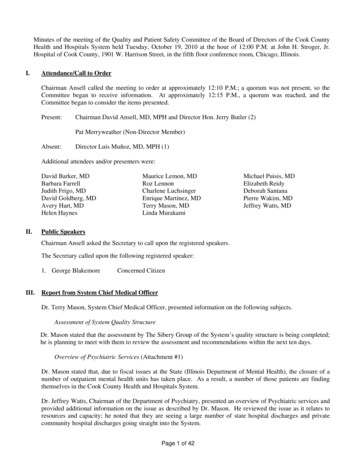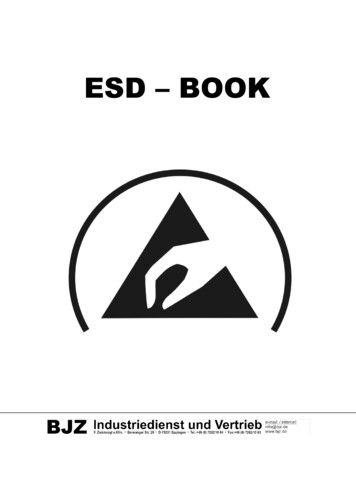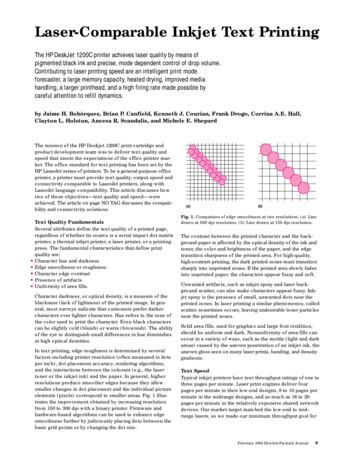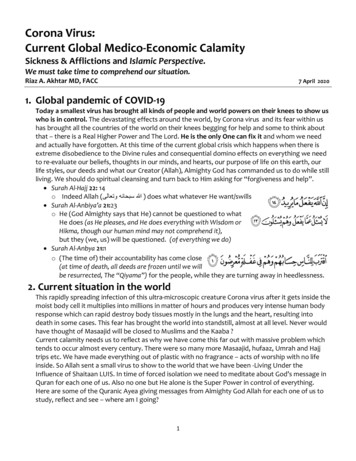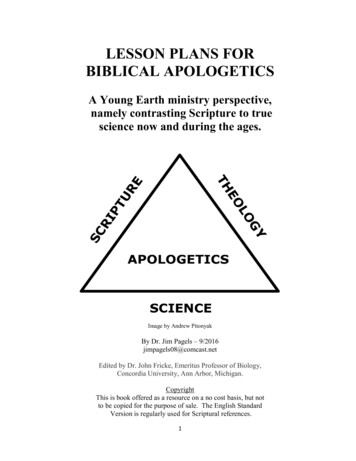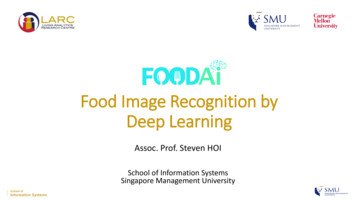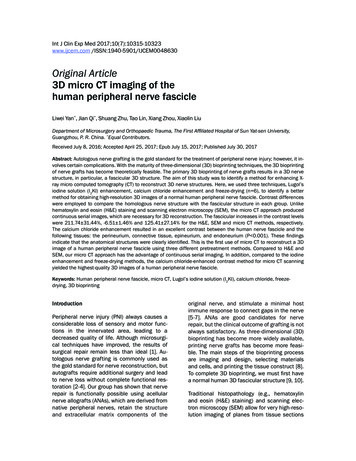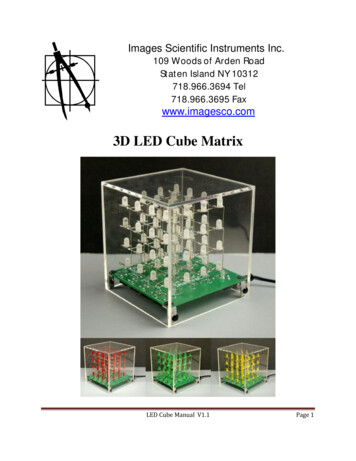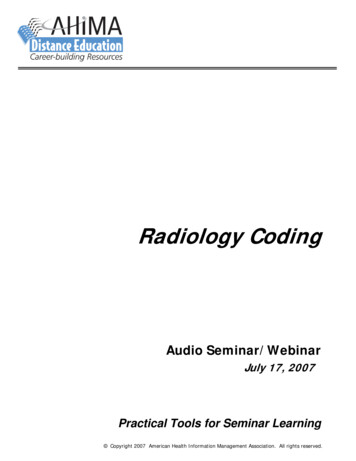
Transcription
AUTEX Research Journal, Vol. 9, No1, March 2009 AUTEXIMAGES OF CORONA DISCHARGES AS A SOURCE OF INFORMATION ABOUTTHE INFLUENCE OF TEXTILES ON HUMANSIzabela L. CiesielskaTechnical University of Lodz,Faculty of Material Technologies and Pattern Designing,Institute of Architecture of TextilesZeromskiego Street 116, 90-543 Lodz, PolandE-mail: Iza.Ciesielska@poczta.fmAbstract:The aim of the experiment was to bring closer the possibilities of using corona discharge photography (CDP),with special emphasis on the impact of textiles on corona discharge photography of human fingertips in contactwith those textiles. The article describes an investigation concerning a short period of contact with textiles andtheir influence on human parameters such as blood pressure (BP) and heart beat (HB) as well as images ofcorona discharges (ICD). The authors were searching for a new method of demonstrating the influence oftextiles on human subjects. As the research involved contact of textiles with human skin, certain static andfriction issues were raised. Textile materials were chosen for the experiments on the basis of their tribologicalfeatures. The ICDs used here were created as a result of placing body parts, e.g. fingers, in the area of a strongelectrical field of high voltage (10 KV) and high frequency (1024 Hz). A digital camera placed within the area ofdischarge recorded this phenomenon. The temperature, air humidity, and air pressure in the examination roomas well as gender, age, HR, BP and in the case of female volunteers, their menstrual cycles, exerted an effect onICD in the study group. ICD of human beings seems to be a kind of marker of tribological features of textilematerials.Key words:Corona discharge, photography of corona discharge, contact with textilesMany facts about CDP appeared many years ago, thanks toSemyon Dawidowicz Kirlian (1900-1980) but the phenomenonitself was already known to the German scientist GeorgChristoph Lichtenberg (1742-1799). He discovered in 1777that electrical discharges exist around the dust. Although thoselight shapes around the objects are named Lichtenberg’sFigures he could not find any use for them.1. Introduction1.1. What is a corona discharge?A corona discharge is an electrical discharge observed ingases which occurs on the surface of charged conductors.The electrical negative and positive corona discharge hasnumerous applications in industry, like decomposition of toxicgases, ozone generation, electrostatic precipitation andcleaning [1].This phenomenon can also be observed around livingorganisms under certain conditions. This specific usage ofcorona discharge is the subject of this study.Figure 2. A typical Lichtenberg figure of an emulsion or film. This isa photographic negative with the streamers black against theunexposed film. Note the impact of ten larger streamer branches.These then parallel the surface, branching still more. The centraldarkening is from diffuse long wavelength ultraviolet from branches.Tips of some smaller branches can be seen on the left. “b” - theradius of the circle containing the impact points of all streamers. “l” –the length of the longest streamer - quotation from page 170 of [3].Figure 1. Original Lichtenberg’s figure [2].http://www.autexrj.org/No1-2009/ 0309.pdf36
AUTEX Research Journal, Vol. 9, No1, March 2009 AUTEXOne of the Polish explorers, Jacob Jodko-Narkiewicz (18471905), a photographer, doctor, and madcap investigator ofelectromagnetism became famous in that field. In 1896 hepublished his precursory investigations into ‘human aura’,as he defined it.the transformation of non-electric phenomena of living andnon-living material. The state of the art analysis of that area ofknowledge shows positive development and the advantageof computerisation for capturing the image of the discharge.1.2. Corona discharge photographySeveral dozen years later, those works were creativelycontinued by the Kirlians from the Soviet Union. The termKirlian Photography derives from their name [4]. SemyonDawidowicz Kirlian (1900-1980) was working in the hospitalas an electrotechnician and repairing a massage device whenhe noticed the electrical discharges between a patient’s skinand the electrode of that device. He worked out an apparatusto fix this phenomenon. Next, together with his wife, Valentine,he continued research on electrical discharges and in 1949Kirlian patented a device for registration of electrical dischargephotography. The results of their researches and observationswere published in 1961 [5]. They described their method asCurrently corona discharge photography, also known as abioelectrophotography, is described as a method used toreveal and record corona discharges created around an object,e.g, human fingertips. An image can be induced when a strongelectrical field of high voltage (e.g. 10 Kv) and high frequency(e.g. 1024 Hz) is produced. A digital camera placed within thearea of corona discharges records this phenomenon.In the presented study, a Gas Discharge Visualisation (GDV)Camera was used to visualise images of corona discharges(ICD).An object is placed on the optic plate (1), the voltage generatoris on (4), while the generated current parameters are 10000kV and 1024 Hz. In the induced electrical field, charge carriers(free electrons and positive or negative ions) (3) present inthe air surrounding the surface of optic plate (2) and the object(1) collide with other charge carriers interacting with oneanother (they attract themselves and mutually neutralise theexcess of different charges). An electrical impulse transmittedto the plate after an object is placed on it stimulates theresponse of the object, by the movement of charge carriers.An acceleration of their movement constantly occurs in theconditions of a stable ionisation process evoked only bycharging a high-frequency current [5-9]. The occurrence ofionisation collisions creates an electron avalanche. Ionisation(electron dissociation from atom) in the electrical field resultsfrom the collision of neutral atoms (or those previously excited)with free electrons accelerated by the field forces [7- 9]. Freeelectron re-association is followed by a visible glow. Thisphenomenon is recorded around the fingertip (Figure 3– 8).Figure 3. Schematic representation of the system used to visualiseICD along with the processed ICD [18, 19] - 1. study object; 2. opticglass plate connected to a power source; 3. discharge; 4. voltagegenerator; 5. optic system; 6. CCD camera (Charge-Coupled Devicesystem with charge-coupling, technology involving light-sensitiveelements); 7. image transducer; 8. image of discharges on thecomputer monitor; 9. processed and analysed image of discharges.Set no 1. ICD of volunteer: female, aged 28 years, registered from fingertips of right hand (from thumb to little finger).Set no 2. ICD of volunteer: male, aged 57 years, registered from fingertips of right hand (from thumb to little finger).Set no 3. ICD of volunteer: male, aged 37 years, registered from fingertips of right hand (from thumb to little finger).http://www.autexrj.org/No1-2009/ 0309.pdf37
AUTEX Research Journal, Vol. 9, No1, March 2009 AUTEX1.3. Living organisms and ICDStatistica for Windows, version 5.1 was employed in the statistical analysis. A multiple regression was used to analyse theeffect of the subjects’ examination conditions, their age, gender, HR and BP on the ICD of respondents.Numerous previous studies involving corona discharges haveprovided evidence that discharges generated around nonliving objects, e.g. coins or stones, do not change their formor shape over time. Corona discharges generated aroundliving organisms are characterised by variations over time [4,6, 10, 11,18-20]. This observation suggests that exogenousenvironmental events, lifestyle, and physical state (also mentalstate in humans) [12,13] of study objects may influence coronadischarges generated around a given animated object [5,14].The Bioethics Committee at the Medical University of Lodzgave permission for the research with participation of humanbeings – agreement no RNN/336/05/KB.2.2. Theoretical analysis of the scheme of the experimentThe first approach was based on the process of reaction andadaptation of human skin receptors to outside stimuli. Contactof skin with textiles evokes a certain reaction of receptors. Itwas considered that the possible reaction to textiles may bean example of ICDs’ parameter changes. It was believed thattextiles evoke reactions of organisms that can be visible onICD.In reports published to date, there are certain findings on theeffect of changes of raw materials in garments but withoutreliable ICD image analysis. It is believed that moisture of theelement of the body that is placed on the optic plate in thedevice is one of the most significant factors influencing thevariations of the ICD. Change in perspiration strongly dependson the activity of the individual and to the garments s/he wears.Despite the high variability of ICD, one may notice certain patterns that are individual to each person. An exemplary set ofICD shows corona discharge photography registered aroundfingertips of volunteers: female, aged 28 years - set no 1; male,aged 57 years – set no 2; male, aged 37 years – set no 3.The second approach undertook the analysis of the generationof charges during static and friction contact of human beingswith textiles. Tribo-electrification is the phenomenon wherebyelectrical charge is generated from abrasion between therelative motions of two contacting surfaces. It is highlydependent on the nature of the materials, the adhesionconditions and the degree of friction and wear [15, 17].1.4. Textiles and corona dischargeThe position of materials in static tribological order is alreadywell-known. To analyse the influence of textiles on corona discharge photography of human beings in brief contact with thosetextiles, three different raw materials were chosen: coarse wool– natural, animal fibre ( ), polyacrylonitryl – man-made synthetic polymer fibre (-) and viscose - man-made natural polymer fibre ( ).In this study it concerns the human forearm and a textile sleeve.It is known that the human body undergoes electrification mainlybecause of:2. Materials and methods–walking (contact of bottom of footwear with a floorsurface and distancing of feet from floor);–friction of body by clothes;–contact with electrified materials, e.g. textiles;–staying in an electric field (induction).2.1. Experiment descriptionLet us consider the steps of the experiment:In all, 20 volunteers (nine men, aged 21-54 years, mean 46 11 years and eleven women, aged 21-57 years, mean 35 12years) were eligible for the study. They were students and instructors from the Institute of Architecture of Textiles. All hadbeen informed about the purpose and the experimental procedure and they were all trained in how to place the finger onthe plate in the same manner with the same pressure. Alltests were performed in the same conditions in room temperature of 18-25 ºC, relative humidity of 28-64 % and atmospheric pressure of 986-1010 hPa.Step 1: The volunteer came into the laboratory wearing a set ofgarments (cotton). The person has already got certain potential.Step 2: The volunteer wears on his bare arm a textile sleeve(100% acrylic). The potential of the person has changed.Friction process takes place between skin and textile materialand additionally contact with textile material itself may influencethe potential of the whole object with sleeve (person sleeve).The examination methods comprised: 1. HR, BP measurements and 2. generation of ICD of ring fingertips of the righthand. The other hand was in contact with the textiles. A respondent bared his or her arm from the wrist to the elbow and puton it a knitted textile, a kind of sleeve made of e.g. coarse wool.The ring finger of the right hand was placed on the plate of theGDV device and a 32-second-long film of corona dischargearound the fingertip was recorded. The procedure was repeatedwith the use of two other textiles, one made of acrylic and theother of viscose. As a reference, a corona discharge film wasrecorded when the arm was bare. That procedure was repeated five times in total for each volunteer, in order to confirmthe results. During each experiment the respondents wore thesame clothes, generally made of cotton, in the whole studygroup.Figure 4. The wearing of the sleeve on the left arm[own researches of author].Step 3: A volunteer keeps a sleeve on his left arm and at thesame time the ring finger of his right hand is in the electricfield. An ICD is registered around this finger.ICDs were recorded with a GDV Camera and analysed withthe use of the GDV Processor Program and GDV SciLab.http://www.autexrj.org/No1-2009/ 0309.pdf38
AUTEX Research Journal, Vol. 9, No1, March 2009 AUTEXFrames from the 32-second-long film registered when a volunteer wears onher left forearm a sleeve made of acrylic knitted fabricFigure 6. Frame no 1. Figure 7. Frame no 160. Figure 8. Frame no 320.(The total area of(TAD 7521)(TAD 7694)discharge in pixels (TAD) 6580)Figure 5. The Gas Discharge Visualisation Camera designed byKonstantin Korotkov, Professor of Physics at St. Petersburg StateTechnical University in Russia [own researches of author].Frames from the 32-second-long film registered when a volunteer doesnot wear a sleeve on her left forearm.Why the ring finger of the right hand?–Because of easy access to this part of the body. Nonecessity to remove garments.–Any part would be sufficient but an ICD of this part of thebody is easy to analyse, and it might be compared to acircle or an ellipse. One should also remember thedifferent perspiration activities of different areas of thebody. Fingers seem to be (given the wetness of the skinsurface) the richest areas as far as the sweat glandsare concerned.Figure 9. Frame no 1.(TAD 9553)Figure 10. Frame no 160. Figure 11. Frame no 320.(TAD 10821)(TAD 10979)Frames from the 32-second-long film registered when a volunteer wearson her left forearm a sleeve made of knitted viscose fabricSome neurophysiologists believe that the ring finger is moresensitive than others, and it was in fact proved by a von FreyHair test [16].Step 4: The volunteer takes off the textile acrylic sleeve andwears the textile viscose sleeve. The friction process takesplace between the skin and the textile material and additionalcontact with the textile material itself may impact on the wholeobject with the sleeve (person sleeve).Figure 12. Frame no 1. Figure 13. Frame no 160.(TAD 9186)(TAD 10854)Step 5: On the left arm a volunteer wears a sleeve and at thesame time the ring finger of the right hand of the volunteer is inthe electric field. An ICD is registered around this finger.Figure 14. Frame no320. (TAD 11026)Frames from the 32-second-long film registered when a volunteer wearson her left forearm a sleeve made of knitted wool fabric.Step 6: The volunteer takes off the textile viscose sleeve andwears the textile coarse wool sleeve. The friction process takesplace between the skin and the textile material and additionalcontact with the textile material itself may impact on the wholeobject with the sleeve (person sleeve).Step 7: On the left arm a volunteer wears a sleeve and at thesame time the ring finger of the right hand of the volunteer is inthe electric field. An ICD is registered around this finger.Figure 15. Frame no 1. Figure 16. Frame no 160. Figure 17. Frame no 320.(TAD 7955)(TAD 9334)(TAD 8987)Step 8: The volunteer takes off the textile coarse wool sleeveand leaves his arm bare. The friction process between theskin and the textile material takes place while the sleeve istaken off. 3.Frames from the 32-second-long film registered when a volunteer wearson her left forearm a sleeve made of knitted acrylic fabric3. ResultsAs a result of the performed experiments a number of 32-secfilms were produced. During each second ten frames of thefilm were recorded. The chosen frames extracted from the 32sec-long films of corona discharge created around the fingertipof the ring finger of right hand of female, aged 43 years areshown in Figures 6-29.http://www.autexrj.org/No1-2009/ 0309.pdfFigure 18. Frame no 1. Figure 19. Frame no 160. Figure 20. Frame no 320.(TAD 14283)(TAD 9273)(TAD 9988)39
AUTEX Research Journal, Vol. 9, No1, March 2009 AUTEXfabric (p 0.0240), knitted acrylic fabric and knitted woolfabric (p 0,0210), knitted acrylic fabric and lack of anyfabric (bare arm) (p 0.0080) as well as during contactwith knitted wool and viscose fabrics (p 0.4980), viscoseand lack of any fabric (p 0.0450) and wool and lack ofany fabric (p 0.0340).Frames from the 32-second-long film registered when a volunteerdoes not wear a sleeve on her left forearm.–There is no correlation between parameters of ICD inthe frame of repetitions of contact with fabrics and withoutfabric. There are no significant statistical differencesbetween mean values of parameters of ICD in the frameof repetition of contact with each textile or without(p 0.5693).–There are significant statistical differences between themean length of radius (p 0.01050) and the coefficientof shape (p 0.0144) in ICD recorded for women andmen. Moreover, as regards the mean length of radius,mean brightness, number of fragments of the ICDsrecorded during contact of volunteers with knitted fabrics.–Menstrual cycle of female volunteers; the later the day ofthe cycle, the higher the value of standard deviation fromthe mean length of radius and the lower the value ofstandard deviation of numbers of fragments.–Gender of volunteers; in ICDs recorded from fingertipsof men, the length of isoline is higher than from fingertipsof women – it derives from the anatomical differencesas usually bigger fingertips are observed in males thanfemales.–Air humidity; the higher the humidity, the higher the lengthof isoline.–Age of respondents and their BP; the older the person,the higher the value of form coefficient.Figure 21. Frame no 1. Figure 22. Frame no 160. Figure 23. Frame no 320.(TAD 12991)(TAD 12985)(TAD 13103)Frames from the 32-second-long film registered when a volunteer wearson her left forearm a sleeve made of knitted viscose fabric.Figure 24. Frame no 1. Figure 25. Frame no 160. Figure 26. Frame no 320.(TAD 13694)(TAD 12135)(TAD 12156)Frames from the 32-second-long film registered when a volunteer wearson her left forearm a sleeve made of knitted wool fabric.4. DiscussionFigure 27. Frame no 1. Figure 28. Frame no 160. Figure 29. Frame no 320.(TAD 11985)(TAD 12021)(TAD 12133)This is one of the first reports on the influence of textiles onvariability in ICD generation of human beings. This researchhas confirmed the influence of factors like temperature andatmospheric pressure, air humidity, HR, BP, age, gender andmenstrual cycle on ICD, which had already been reported byauthors of other publications [4-8].The GDV SciLab program calculates the following parametersof film:––The total area of discharge in pixels (TAD).–Mean length of radius (length section being the result ofsubtraction between the maximum distant and theminimum distant pixel from the centre of ICD with bothpixels lying on the same radius of ICD).–Normalised deviation of isoline radius (the quotient ofstandard deviation of isoline to the mean value of thelength of radius of ICD.––Mean brightness (in the range 0-255).–The analysis of the 32-second-long films from coronadischarges shows that:–There is a linear correlation r 0.8 between parametersof ICD, defined for all films recorded during contact withknitted fabrics and without knitted fabric.–There are significant statistical differences betweenmean values of parameters of ICD recorded duringcontact with knitted acrylic fabric and knitted viscoseCoefficient of shape (a quotient of the length of isoline tothe mean length of radius multiplied by 2).Significant statistical differences between all parameters ofICD in the case of contact with knitted acrylic fabric and otherfabrics as well as while there was no contact with fabrics arepuzzling.It may be connected with skin sensory factors and the processof adaptation of organisms to a new object – textiles. Not onlythe subjective sensory perception (touch) could play a rolehere, however, but also greater ability of the fabric to chargeaccumulation. It is noteworthy that the raw material of garmentsworn by the respondents during the experiment might alsohave influenced their ICDs. It means that the influence ofgarments on ICDs of humans should be given consideration.It may be connected with an electrostatic charge, which isaccumulated on the surface of clothes and additionally decidesthe human electrostatic potential (human clothes). Hence, itcould determine ‘the response’ in ICD’s changeable character.Detailed analysis is only possible with parametric analysis ofthe digital ICDs. ICDs of respondents allow general gradationof the textiles with which they have contact. It means that arange of textiles made of different raw materials such as coarsewool, acrylic and viscose are factors influencing theThe number of fragments of the image (the number ofseparate fragments of the picture).http://www.autexrj.org/No1-2009/ 0309.pdf40
AUTEX Research Journal, Vol. 9, No1, March 2009 AUTEXchangeability of parameters of 32-second-long film of coronadischarge registered around the fingertips of volunteers aftershort periods of contact with those textiles. The reason for thedifferences might be the duration of the process of adaptationby the organism (the adaptation of the organism to the textileswhile registering the discharges) and adaptation of receptorsin human skin to the textiles. Although there is a possibility ofranging the textiles: the lowest value of TAD was gained whena volunteer had contact with acrylic fabric, a higher value of thisparameter was obtained by wool, then viscose, and the highestvalue was achieved when a volunteer did not have contact withany fabric in the form of a sleeve. The presented results aretrue only for 65% of the examined population. In 30% of theremainder certain deviations from the presented order werenoticed. They concern the differences between the range ofviscose and lack of sleeve. In 5% of the examined populationdeviations from the order presented above were noted. Theyseem to be a consequence of the individual features ofexamined subjects, e.g. perspiration, skin roughness.There is no ground for considering registered films assufficient evidence of whether the impact of outsidefactors, i.e. textiles, has an advantageous ordisadvantageous effect on human beings. Potentialcreated while they are wearing sleeves might be reflectedin ICD because of the generation of charges betweenthe skin of the forearm and the surface of the fabric. Thereflection is possible on account of the fact that a humanfinger plays the role of an electrode in a GDV Cameradevice. Discharge photography may mean there is apossibility of analysing the peak voltage of the object(human textiles).2.It is likely that further studies of electrography willcontribute to better use of the observed changes incorona discharges in assessing influences of outsidefactors on human beings, like detecting lightning.com/frames/lichtenbergs.html. Thewebsite devoted to Georg Christoph Lichtenberg.3.Loeb, L. Electrical coronas. University of California Press,1965.4.Korotkov, K. Human Energy Field. Backbone New York,2002.5.Kirlian, S.D. Kirlian W. C. (Fotografirovanie i wizualnojenabludenie pri posredstwie took wysokiej czastoty. urnalnaucznoj i prok³adnoj fotografii i kinematografii), Thephotography and visualisation of matter by the means ofhigh frequency current, Journal of Photography andCinematography, 6 397-403, 1961.6.Flisowski, Z. The technique of high voltage (in Polish).Wydawnictwa Naukowo-Techniczne, 1999.http://www.autexrj.org/No1-2009/ 0309.pdfPehek, J., Kyler, H. Faust, D. Image Modulation in CoronaDischarge Photography. Science 194, page: 4262 - 4269,1976.9.Opaliñski, J. Kirlian-type images and the transport of thinfilm materials in high-voltage corona discharges. J.Appl.Phys 50 (1), page: 498-504, 1979. ΔThe financial support provided by the State Committee forScientific Research for the project, ‘The analysis of the influenceof textiles on human beings’, is gratefully acknowledged.J. Zhang, K., Adamiak, G.S.P. Castle. Numerical modellingof negative-corona in oxygen under different pressures.Journal of Electrostatics 65, 174–181, 2007.8.11. Szosland, J. Corona discharges in system: human clothes(in Polish) Part 1: Textile Review – Polish edition no. 12,2003.Acknowledgements1.Iovine, J. Kirlian Photography, a hands-on guide. TABBooks, USA, 1994.10. Greyson, D. Seasonal Lighter Note Kirlian PhotographyFilm Artifacts. Journal of the Canadian Association ofRadiologists, 40, page: 331, 1989.5. Conclusion1.7.41
1.2. Corona discharge photography Currently corona discharge photography, also known as a bioelectrophotography, is described as a method used to reveal and record corona discharges created around an object, e.g, human fingertips. An image can be induced when a strong electri
